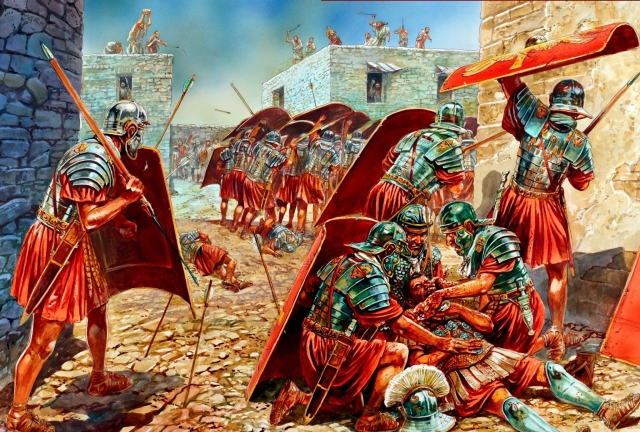Hadrian was the emperor of Rome from the years 117-138. Born into a Roman family which had immigrated to Spain from Italy some 250 years previously, his father was a senatorial official and Emperor Trajan's first cousin. Hadrian was zealous in pursuing his imperial ambitions and personal goals. He followed an imperial escort of professionals and bureaucrats to practically every empire province. He promoted military readiness and discipline, and he supported, planned, or financed a variety of civil and religious institutions and construction projects. Hadrian reconstructed the Pantheon and built the massive Temple of Venus and Roma in Rome. Hadrian also established a popular cult late in his reign due to his deep attachment with Greek teenager Antinous and the latter's untimely death. Notoriously, Hadrian put down the Bar Kokhba insurrection in Judea (Roman: Judaea), but his rule was otherwise described as quiet.
Hadrian sought to incorporate the Jewish Temple located in Jerusalem in the province of Judea into the conventional Roman civic-religious Imperial cult; such assimilations had long been the norm in Greece and other provinces and had shown to be effective. The Samaritans, who lived nearby, had already merged their religious practices with Hellenistic ones. Imperial demands were more difficult to persuade than strict Jewish monotheism. Simon Bar Kokhba led a major anti-Hellenistic and anti-Roman Jewish insurrection. It was a tumultuous time on both sides. Tinius Rufus, the Roman governor, requested an army to quell the resistance; and Bar Kokhba physically punished every Jew who refused to join him, even going so far as to kill. According to Justin Martyr and Eusebius, the punishment of purported Jews had to do with new Christian converts who resisted Bar Kokhba's own messianic claims.
Given the fragmentary nature of evidence, an exact date for the uprising's start is impossible to determine, but it most likely occurred between the summer and fall of 132. The Romans were overwhelmed by the uprising's organized ferocity, seemingly thought to be caused by the Hadrianic law that outlawed circumcision, a religious rite that Jews held as non-negotiable as God had instructed Abraham to circumcise himself and all the males within his household.
Hadrian summoned his general, Sextus Julius Severus, who hailed from Roman Brittania and gathered troops from as far as the Danube. A legion, or its numeric equivalent of about 4,000 soldiers, was lost by the Romans. By 135, the insurrection was put down. According to Cassius Dio, Roman army activities in Judea resulted in the deaths of 580,000 Jews and the destruction of 50 walled towns and 985 villages.
After the fall of the Judean rebellion, a substantial percentage of the population was enslaved and thus began the Jewish diaspora as many were shipped to Roman provinces across the empire, from northeast of Judea in the Caucuses all the way to the far reaches of Western Europe, . After a three-and-a-half-year siege, Beitar, a fortified city 10 kilometers (6.2 mi) southwest of Jerusalem, fell. Despite the immaculate records kept by the Romans, the scope of punitive measures against the Jewish community in Beitar is still debated due to conflicting reports from Roman archives.
To punish the Judeans, Hadrian renamed the province Syria Palaestina and deleted the 'Judea Province' name from the Roman map, effectively incorporating it into the surrounding land as punishment for the uprising. He chose Palestina to humiliate the Jews after the arch-nemesis of the Israelites, the ancestors of the Judeans, the Philistines.
Hadrian then renamed Jerusalem Aelia Capitolina in honor of himself and modified the Jewish Temple, which was partially destroyed during the uprising, as a way to further punish the Judeans. He incorporated Greek-style columns and erected statues of Roman gods into it. He renamed the Temple Jupiter Capitolinus. According to Epiphanius, Hadrian appointed Aquila from Sinope in Pontus as "overseer of the construction of erecting the city" because he was connected to him by marriage. Aquila was responsible for removing or covering the signs of Judaism that filled the walled city and refacing it in the Roman style that is now evident in the excavations all across today's Old City.


